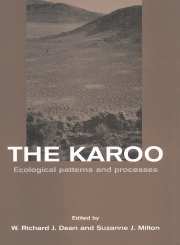Part four - Human impacts
Published online by Cambridge University Press: 23 December 2009
Summary
The following three chapters treat some of the basic and major prehistoric and modern land use economies and their impacts in the karoo. In keeping with the theme of this book, the impacts are expressed essentially in ecological contexts, rather than in terms of economics or sociology. The chapters do not constitute a complete and comprehensive account of human impacts on karoo ecosystems.
The thesis running through much of the discourse in the following chapters stems from a premise that the environment influences people, and people influence the environment. In this context, the two primary environmental factors in the karoo are climate and geology or, more particularly, soils. Summary propositions on these two factors follow.
The environment
The soils of the karoo are not deficient in basic elements and minerals (Watkeys, this volume); contrasting, for example, with the condition of the neighbouring fynbos biome in which nitrogen and phosphorus are in scarce supply (Stock and Allsopp, 1992). As a generalization, it is fair to say that primary production is not limited by infertile soils in the karoo.
The ambient temperature regime for much of the karoo is temperate (Desmet and Cowling, this volume). Prolonged extremes of cold (below 5 °C) and heat (above 35 °C) are generally abnormal. The relatively low incidence of persistent frost appears to be important in the karoo's extraordinary development of succulent vegetation (Cowling and Hilton-Taylor, this volume). In short, ambient temperatures are relatively unimportant in limiting primary production, and human occupation, in the karoo.
The availability of water is of overriding importance in influencing production, both primary and secondary, and human dispersion in the karoo.
- Type
- Chapter
- Information
- The KarooEcological Patterns and Processes, pp. 239 - 242Publisher: Cambridge University PressPrint publication year: 1999
- 2
- Cited by



